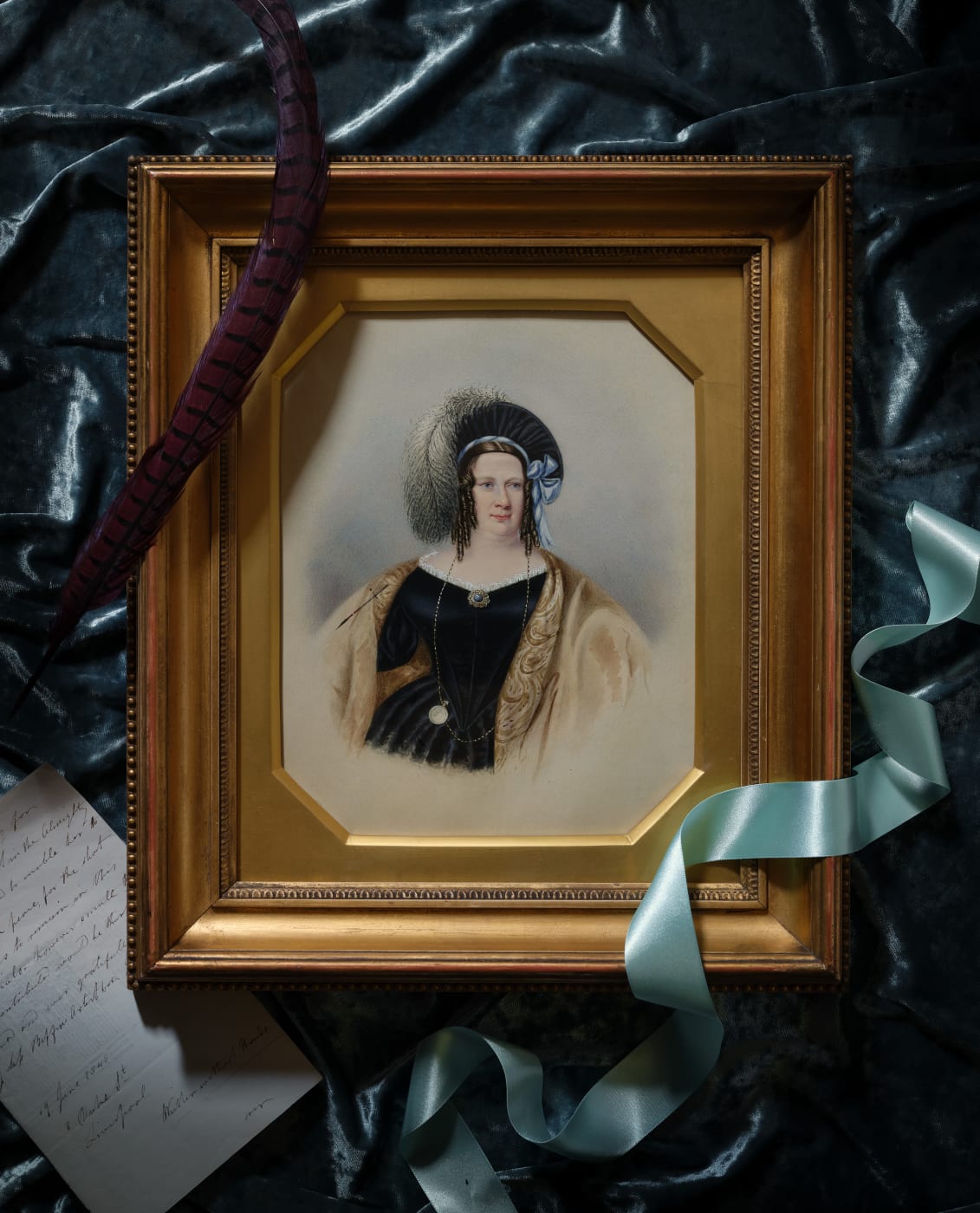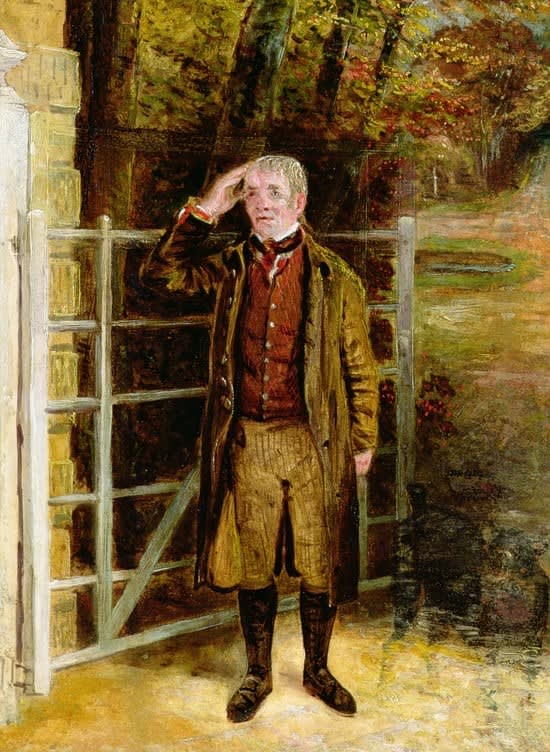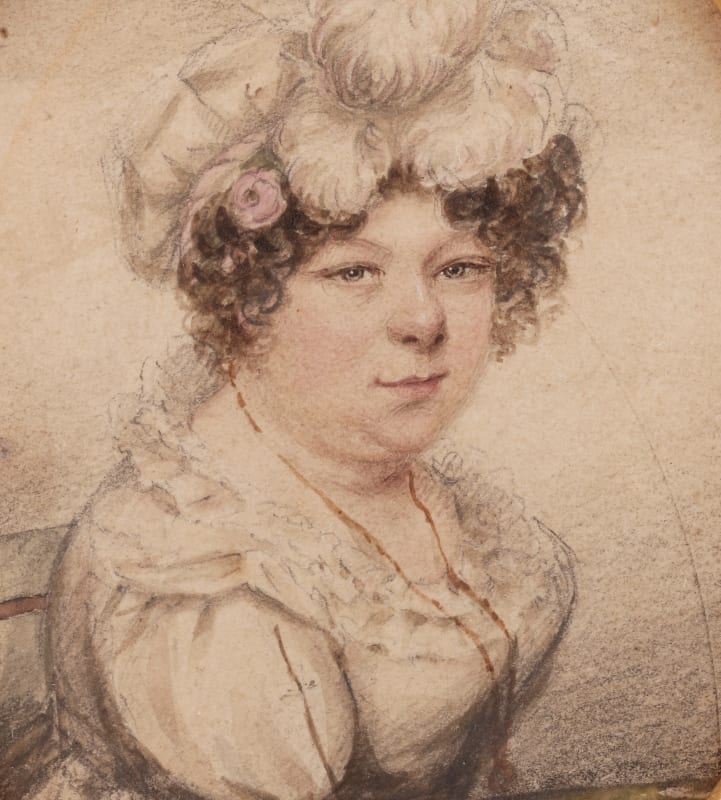The Wrong Mr Wright
by Valeria Vallucci
Researching Miss Biffin’s marriage to Mr Wright has been a captivating process.
The details of their nuptials, unfolded across surprising distances of time and space, captured the imagination of a certain type of reader in an age obsessed with the rituals of propriety. It is hard to imagine a more quintessential tale of early Victorian England.[1]
Sadly, the papers paid much less attention to the identity and character of Miss Biffin’s groom. All that was generally known about him at the time was that he was “Mr William Stephen Wright, a gentleman [who] had long been attached to her”.[2] The couple had, therefore, been in some sort of relationship for a few years, when Miss Biffin was starting her professional career as a miniature artist. Soon after the wedding, the groom – who could not have had a more deceptive name than Mr (W)Right – supposedly abandoned his artistic bride.
One witness described him as “a vile adventurer, who ran through her money and left her to starve”.[3] However, this view was rejected in the ‘Appeal to the Public’ published by Richard Rathbone on behalf of Miss Biffin towards the end of her life:
[…] the match was unfortunate, they never lived together, and Mr Wright soon ceased to visit her. But it is not true, as has been ill-naturedly asserted, that he received from her, on their marriage, a considerable sum of money, which he appropriated to himself, and immediately afterwards deserted her.
On the contrary, Miss Biffin is anxious to state, that she was not, at that time, possessed of £10 in the world, and, also, that Mr Wright, so long as he had the ability to do so, allowed to her, out of a very moderate salary, £40 per annum.[4]
Despite Miss Biffin’s ‘anxious’ attempt to paint a less negative picture of her former husband, her words about him seem kinder than one might have expected. But why?
Miss Biffin presented herself as a rather beautiful and fashionable lady. In her self-portraits she painted herself with sumptuous hair, intelligent eyes, and an attractive face. Not only was she a woman of artistic talents, but she was also good company, told entertaining stories and had a contagious “cheerful laugh”.[5] Could Mr Wright have fallen for her beauty and genius? It would have made sense if Mr Wright had been a member of the London-based family of notable miniature painters (John, Priscilla and John William Wright) or George Dawe-related Wright engravers. Unfortunately, this is not the case.
The aura of mystery around Mr Wright has inspired new research. Unfortunately, ‘William Wright’ is one of the most common names in both Britain and America in the first half of the Nineteenth Century. Just to give an idea of how many there were, in 1837 Queen Adelaide’s Treasurer was dealing with three different men named “Wm Wright” at the same time: a stationer from Windsor, a wood seller and a pay-office assistant.[6] The deeper I dig, the more ‘Wm Wrights’ I unearth: tobacconists, horse-hair-manufacturers, ink-makers, victuallers, cotton and seed dealers, innkeepers, and accountants. The name fails to provide a clue to his appearance or identity either. The portraits above are all of men named William Wright.[7] They include an actor, a romantic reverend, a hopeless rogue, and a one-eyed aristocrat. And while I am inclined to believe Biffin’s Mr Wright was indeed a rogue, I cannot find a single reference to one who fits with what we know of her life and work. Perhaps this supposed ‘gentleman’, this penniless Don Giovanni from the Strand, had many lives?
This is what we know for sure:
William Stephen Wright was born in the parish of St. Martin-in-the-Fields, London some time before 1803.[8] He was later described as “a gentleman formerly of the navy, but who had been for some years in the habit of attending the celebrated Miss Biffen”. April 1824 finds him in Dover, where there is a record of him being assaulted by a paper-manufacturer, a “Mr P.” (possibly Messrs Phipps and Sons), who left Mr Wright ‘in an almost senseless state, bleeding profusely about the mouth, his head hideously swelled, and his features altogether disfigured that his nearest acquaintance could scarcely recognize him’.[9] At the end of the summer of that year Wright temporarily moved to Somerset. On 28th August 1824 he applied for a marriage licence in the Parish of Kilve as ‘a gentleman, a bachelor of 21+ years’. He swore before a Parish clerk called E. Foster that he had taken residence in Kilve.[10] On 6th September he married the 40-year-old Sarah Biffin in the Church of Kilton. The marriage was celebrated by Father John Hole in the presence of Mary Ann and Simon Blackmore, Biffin’s cousins.[11] Soon after the wedding, Mr Wright left the artist.
To the above, we need to add that Miss Biffin’s death certificate describes her as a ‘widow – banker’s clerk’.[12] However, this information cannot be verified.
Other aspects of his life are less certain. This ex-Navy gentleman from London, who after the Congress of Vienna became chaperone to the celebrated artist, is hard to pin down. I first thought that knowing his middle name and place of birth would help me locate him. I could not have been more wrong, as Georgian St Martin’s was a wide parish inhabited by many Wright households and taxpayers. My first hunch was that he may have been employed as a clerk in one of the Navy offices, but I have found no trace of him in The Royal Kalendar. [13] Was he then the Wm. Wright enrolled as purser in the Navy on 14th December 1807?[14] Or the assistant surgeon of 24th December 1810?[15] Or the Navy agent based at 108, Drury Lane, London in 1811?[16] During the Napoleonic Wars there had been a wealth of military Mr Wrights – but almost certainly not ours – who were majors, lieutenants survivors of Waterloo, and proud pensioners.
It is possible that Mr Wright was not even in the Navy? Two slightly different versions of the report article of the assault in Dover were published in April 1824. The one in the Kentish Weekly Post mentioned his Navy background. But this significant detail was absent from the Morning Herald. [17] Perhaps the Kentish Weekly was mistaken. Perhaps he worked for the East India Company? After all, several William Wrights appear in their records as East India Company brokers or auditors.[18]
My favourite William Wright of all is the bankrupt medicines vendor – possibly a real-life version of ‘Dr Dulcamara’ from Donizetti’s L’Elisir d'Amore – who pops up in Bristol in 1818 and reappears, still bankrupt, in Hanover Square, London in 1826.[19] Would not such a travelling apothecary have made a perfect operatic match for a touring artist?
There are still dozens of other namesakes who might fit the bill but fail to convince. For instance, a William Stephen Wright was a licensed stationer and lottery agent at 46 High Street, Bristol, between 1810 and 1814. He offered a reading room with papers from London and the provinces, as well as medallions, gold papers and ornaments and ‘caricatures, drawings, etc’. before becoming insolvent.[20] He re-emerged in Portishead a year later in the same financial situation.[21] This dealer (or someone else with exactly the same unpropitious name) was robbed of ‘drapery and other goods’ in his shop in Taunton in 1816.[22] Would Miss Biffin have started an association with the ruined gambling agent-turned-draper during one of her trips to the south-west?[23] If he was a draper, perhaps he would have had access to tailor-made clothes to dress as a ‘gentleman’ and to provide Miss Biffin with the stylish outfits we can spot in her self-portraits. This might – or might not - be connected to the fact that a newspaper once reported incorrectly that Miss Biffin’s father was himself a draper, which makes me think someone in her life must have been one.[24]
Unfortunately, we are left with a guessing game. No matter the facts, chasing the wrong Mr Wright has helped me shape a view of Miss Biffin herself. I began to see her not only as an artist but also as an extraordinary and resourceful woman. As unromantic it might sound, Mr & Mrs Wright were for some time in a mutually advantageous partnership. Though we cannot be sure about his profession, Mr Wright certainly helped his famous companion arranging transport and lodgings and sourcing the whole range of art material, as if he was her agent. And Miss Biffin provided him with the lifestyle he would have enjoyed if his career in the Navy or elsewhere had not been interrupted by misfortune, misconduct, or simply the harshness of the Napoleonic Wars. There is still much to discover about William Stephen Wright, and the more we know about him, the greater the insight we will have into the life and work of the remarkable Sarah Biffin.
_________________________________________________
[1] For a flavour of the discourse, consider reading the following articles: “Ladies’ Fourth Finger” in Saint James's Chronicle, 28 June 1825; Morning Herald, 18 May 1830, p. 6; “The Lion-Huntress of Belgravia” in Punch, or The London Charivari, 3 November 1855; “Curious Wedding Stories” in The Evening Telegraph, 3 May 1878.
[2] Morning Herald, 18 May 1830.
[3] The Evening Telegraph, 3 May 1878.
[4] Liverpool Mercury, 22 October 1847.
[5] Morning Post, 22 February 1843.
[6] Royal Archives GEO/BOX/17a, Queen Adelaide Accounts 1830 – 1849, “Her Most Excellent Majesty The Queen Subject to Drafts of Hon. William Ashley Treasurer with Messrs Coutts & Co. 1835-1838”.
[7] Heinz Archive, ‘William Wright’ sitter folder.
[8] Somerset Archives, Marriage Registers, Kilton 1813-1835 (ancestry.co.uk).
[9] Kentish Weekly Post, 16 April 1824.
[10] Somerset, Marriage Bonds and Allegations, Diocese of Bath and Wells, 1824 (ancestry.co.uk).
[11] Somerset, Marriage Registers, Kilton, 1813-1835 (ancestry.co.uk).
[12] Liverpool Archives. Thanks to Ellie Smith for the information.
[13] The Royal Kalendar for the Year 1816, 1817, 1821, 1824.
[14] The Navy List, Jan-April 1815: Jan p. 129; Feb pp. 47 and 131; Apr p. 129.
[15] The Navy List, Jan-April 1815: Jan pp. 42 and 123; Feb pp. 43 and 125; Apr p. 123.
[16] 1811 London and Country Directory (ancestry.co.uk).
[17] Quoting the Kentish Gazette (Morning Herald, 16 April 1824).
[18] Law Chronicle, Commercial and Bankruptcy Register, 28 July 1814; The Treble Almanack for the Year 1812.
[19] https://www.thegazette.co.uk/London/issue/17340/data.pdf;https://www.thegazette.co.uk/London/issue/1 8251/page/1270.
[20] Bristol Mirror, 22 December 1810; 2 February 1811; 8 January 1814.
[21] Cheltenham Chronicle, 23 November 1815; https://www.thegazette.co.uk/London/issue/17081/page/2313.
[22] Taunton Courier and Western Advertiser, 4 April 1816.
[23] For an updated timeline of Miss Biffin’s life see “Without Hands” The Art of Sarah Biffin, edited by Emma Rutherford and Ellie Smith, Philip Mould & Company, 2022.
[24] Morning Herald, 18 May 1830.












